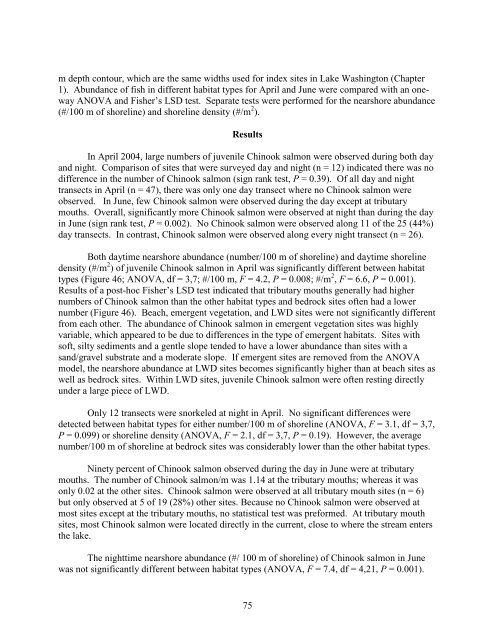Nearshore Habitat Use by Juvenile Chinook Salmon in Lentic ...
Nearshore Habitat Use by Juvenile Chinook Salmon in Lentic ...
Nearshore Habitat Use by Juvenile Chinook Salmon in Lentic ...
Create successful ePaper yourself
Turn your PDF publications into a flip-book with our unique Google optimized e-Paper software.
m depth contour, which are the same widths used for <strong>in</strong>dex sites <strong>in</strong> Lake Wash<strong>in</strong>gton (Chapter<br />
1). Abundance of fish <strong>in</strong> different habitat types for April and June were compared with an oneway<br />
ANOVA and Fisher’s LSD test. Separate tests were performed for the nearshore abundance<br />
(#/100 m of shorel<strong>in</strong>e) and shorel<strong>in</strong>e density (#/m 2 ).<br />
Results<br />
In April 2004, large numbers of juvenile <strong>Ch<strong>in</strong>ook</strong> salmon were observed dur<strong>in</strong>g both day<br />
and night. Comparison of sites that were surveyed day and night (n = 12) <strong>in</strong>dicated there was no<br />
difference <strong>in</strong> the number of <strong>Ch<strong>in</strong>ook</strong> salmon (sign rank test, P = 0.39). Of all day and night<br />
transects <strong>in</strong> April (n = 47), there was only one day transect where no <strong>Ch<strong>in</strong>ook</strong> salmon were<br />
observed. In June, few <strong>Ch<strong>in</strong>ook</strong> salmon were observed dur<strong>in</strong>g the day except at tributary<br />
mouths. Overall, significantly more <strong>Ch<strong>in</strong>ook</strong> salmon were observed at night than dur<strong>in</strong>g the day<br />
<strong>in</strong> June (sign rank test, P = 0.002). No <strong>Ch<strong>in</strong>ook</strong> salmon were observed along 11 of the 25 (44%)<br />
day transects. In contrast, <strong>Ch<strong>in</strong>ook</strong> salmon were observed along every night transect (n = 26).<br />
Both daytime nearshore abundance (number/100 m of shorel<strong>in</strong>e) and daytime shorel<strong>in</strong>e<br />
density (#/m 2 ) of juvenile <strong>Ch<strong>in</strong>ook</strong> salmon <strong>in</strong> April was significantly different between habitat<br />
types (Figure 46; ANOVA, df = 3,7; #/100 m, F = 4.2, P = 0.008; #/m 2 , F = 6.6, P = 0.001).<br />
Results of a post-hoc Fisher’s LSD test <strong>in</strong>dicatedthat tributary mouths generally had higher<br />
numbers of <strong>Ch<strong>in</strong>ook</strong> salmon than the other habitat types and bedrock sites often had a lower<br />
number (Figure 46). Beach, emergent vegetation, and LWD sites were not significantly different<br />
from each other. The abundance of <strong>Ch<strong>in</strong>ook</strong> salmon <strong>in</strong> emergent vegetation sites was highly<br />
variable, which appeared to be due to differences <strong>in</strong> the type of emergent habitats. Sites with<br />
soft, silty sediments and a gentle slope tended to have a lower abundance than sites with a<br />
sand/gravel substrate and a moderate slope. If emergent sites are removed from the ANOVA<br />
model, the nearshore abundance at LWD sites becomes significantly higher than at beach sites as<br />
well as bedrock sites. With<strong>in</strong> LWD sites, juvenile <strong>Ch<strong>in</strong>ook</strong> salmon were often rest<strong>in</strong>g directly<br />
under a large piece of LWD.<br />
Only 12 transects were snorkeled at night <strong>in</strong> April. No significant differences were<br />
detected between habitat types for either number/100 m of shorel<strong>in</strong>e (ANOVA, F = 3.1, df = 3,7,<br />
P = 0.099) or shorel<strong>in</strong>e density (ANOVA, F = 2.1, df = 3,7, P = 0.19). However, the average<br />
number/100 m of shorel<strong>in</strong>e at bedrock sites was considerably lower than the other habitat types.<br />
N<strong>in</strong>ety percent of <strong>Ch<strong>in</strong>ook</strong> salmon observed dur<strong>in</strong>g the day <strong>in</strong> June were at tributary<br />
mouths. The number of <strong>Ch<strong>in</strong>ook</strong> salmon/m was 1.14 at the tributary mouths; whereas it was<br />
only 0.02 at the other sites. <strong>Ch<strong>in</strong>ook</strong> salmon were observed at all tributary mouth sites (n = 6)<br />
but only observed at 5 of 19 (28%) other sites. Because no <strong>Ch<strong>in</strong>ook</strong> salmon were observed at<br />
most sites except at the tributary mouths, no statistical test was preformed. At tributary mouth<br />
sites, most <strong>Ch<strong>in</strong>ook</strong> salmon were located directly <strong>in</strong> the current, close to where the stream enters<br />
the lake.<br />
The nighttime nearshore abundance (#/ 100 m of shorel<strong>in</strong>e) of <strong>Ch<strong>in</strong>ook</strong> salmon <strong>in</strong> June<br />
was not significantly different between habitat types (ANOVA, F = 7.4, df = 4,21, P = 0.001).<br />
75
















